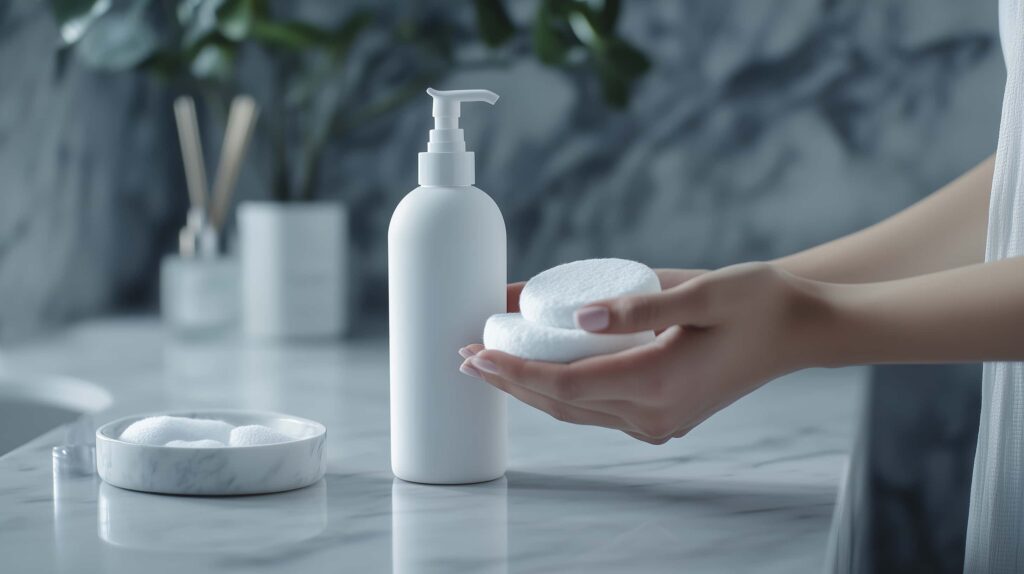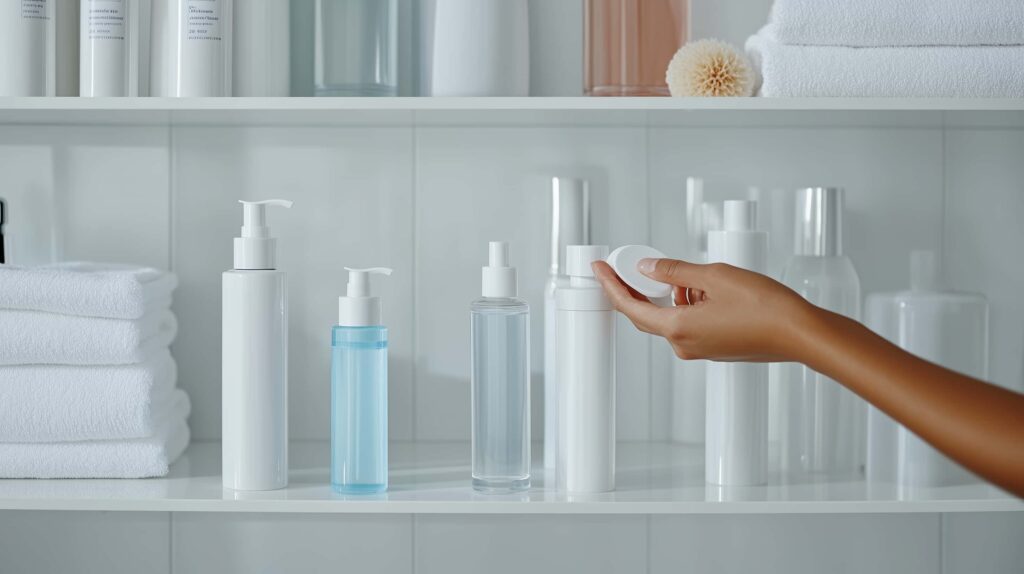9 Micellar Waters vs. Cleansing Milks: Which is Right for Your Skin?
Navigating the vast landscape of skincare can be overwhelming, especially when choosing the right cleanser. Two popular options that often come up are micellar waters and cleansing milks. Both promise effective cleansing without stripping your skin of its natural moisture, but how do they compare? Whether you’re dealing with dryness, sensitive skin, or simply seeking a more natural approach, understanding the differences between micellar waters and cleansing milks is essential. This guide will help you make an informed decision by exploring their benefits, suitability for different skin types, and tips for incorporation into your skincare routine.

Understanding Micellar Waters
Micellar water has become a beloved staple in many skincare routines for its simplicity and effectiveness. But what exactly is micellar water?
At its core, micellar water is a gentle, no-rinse cleanser composed of micelles—tiny oil molecules suspended in soft water. These micelles act like magnets, attracting and trapping dirt, oil, and makeup from the skin without the need for harsh rubbing or rinsing. This unique structure allows micellar water to cleanse effectively while maintaining the skin’s natural barrier, making it an appealing option for those seeking a minimalist yet efficient cleansing solution.
Suitable for various skin types, including sensitive and acne-prone skin, micellar water offers a hassle-free cleansing experience. Whether you’re rushing through your morning routine or winding down after a long day, micellar water provides a quick and effective way to cleanse your skin without compromising its health.

Benefits of Micellar Waters
Micellar waters offer numerous advantages that make them a favored choice among skincare enthusiasts:
- Convenience and Ease of Use: No need for rinsing makes micellar water perfect for on-the-go cleansing, travel, or quick touch-ups.
- Gentle Cleansing: Effectively removes dirt, oil, and makeup without abrasive scrubbing, minimizing the risk of irritation.
- Hydrating Properties: Often contains hydrating ingredients like glycerin or hyaluronic acid, leaving the skin soft and supple.
- Versatility: Suitable for various skin types and can be used as a primary cleanser or makeup remover.
- Non-Comedogenic: Formulated to avoid clogging pores, making it safe for acne-prone skin.
- Eco-Friendly Options: Many brands offer recyclable packaging, catering to environmentally conscious consumers.
- Minimalist Skincare Routine: Serves as an all-in-one cleanser, reducing the need for multiple products.
- Anti-Aging Benefits: Some formulations include antioxidants and vitamins that protect the skin from environmental stressors.
- Cost-Effective: Multifunctional use eliminates the need for separate cleansers and makeup removers, offering great value.
Micellar water combines efficiency with gentleness, making it a versatile and valuable component of any skincare routine.

Exploring Cleansing Milks
Cleansing milks offer a creamy and nourishing alternative to traditional cleansers. But what sets them apart?
Cleansing milks are formulated with a blend of water and oils, creating a luxurious, emollient texture that glides smoothly over the skin. Unlike traditional milk cleansers that contain dairy, modern cleansing milks are typically dairy-free, making them suitable for various skin sensitivities and preferences.
The primary purpose of cleansing milks is to dissolve makeup, sunscreen, and impurities without stripping the skin of its natural oils. The gentle emulsification process ensures that even stubborn makeup is effectively removed while maintaining the skin’s moisture balance. This makes cleansing milks particularly beneficial for dry or mature skin types that require extra hydration and care.
Many cleansing milks are enriched with nourishing ingredients such as botanical extracts, vitamins, and fatty acids. These components not only aid in cleansing but also provide additional skincare benefits, such as soothing irritation, improving elasticity, and promoting a healthy skin barrier. As a result, cleansing milks offer a holistic approach to cleansing, addressing both the removal of impurities and the overall health of the skin.

Benefits of Cleansing Milks
Cleansing milks bring a host of benefits to the table, making them a cherished choice for those seeking a gentle yet effective cleansing solution:
- Deep Hydration: The rich, creamy texture provides intense hydration, ideal for dry and sensitive skin types.
- Gentle Makeup Removal: Excels at dissolving makeup, including waterproof and long-wear formulas, without harsh rubbing.
- Maintains Skin Barrier: Preserves the skin’s natural oils, maintaining the integrity of the skin barrier.
- Soothing Properties: Contains soothing ingredients like aloe vera and chamomile, calming irritated or inflamed skin.
- Anti-Aging Benefits: Enriched with antioxidants and vitamins that combat signs of aging by neutralizing free radicals.
- Versatile Usage: Suitable for all skin types and can be used alone or as part of a double cleansing method.
- Luxurious Experience: Offers a pampering and indulgent cleansing experience with its creamy texture and pleasant fragrances.
- Non-Stripping Formula: Cleanses without stripping essential oils, maintaining a balanced and comfortable skin feel.
- Complementary to Other Products: Prepares the skin for subsequent skincare products, enhancing absorption and effectiveness.
Cleansing milks provide a comprehensive cleansing solution that not only removes impurities but also nurtures and protects the skin.

Comparing Micellar Waters and Cleansing Milks
Choosing between micellar waters and cleansing milks requires understanding how they compare across various factors:
1. Texture and Consistency
- Micellar Waters: Lightweight and watery, easily absorbed by the skin, ideal for quick application.
- Cleansing Milks: Creamy and rich, offering a more substantial cleansing experience, beneficial for dry or mature skin.
2. Application Method
- Micellar Waters: Applied using a cotton pad with no rinsing required, perfect for travel or busy routines.
- Cleansing Milks: Applied directly to dry skin, massaged in to dissolve makeup, often requiring rinsing or wiping away.
3. Cleansing Power
- Micellar Waters: Effective at removing light to moderate makeup and impurities without being overly harsh.
- Cleansing Milks: Adept at dissolving heavier makeup and sunscreen, ensuring a deep cleanse while keeping the skin hydrated.
4. Hydration and Moisture
- Micellar Waters: Primarily focused on cleansing, with some hydrating ingredients.
- Cleansing Milks: Highly moisturizing, replenishing the skin’s moisture barrier, ideal for maintaining hydration.
5. Suitable Skin Types
- Micellar Waters: Versatile for various skin types, including oily and acne-prone skin.
- Cleansing Milks: Best suited for dry, sensitive, or mature skin types requiring extra nourishment.
6. Time and Convenience
- Micellar Waters: Quick and easy application with no rinsing, saving time in daily routines.
- Cleansing Milks: Slightly more time-consuming due to application and potential rinsing, but offers a thorough cleanse.
7. Environmental Considerations
- Micellar Waters: Often come in recyclable packaging and require minimal water usage.
- Cleansing Milks: Packaging varies, but many brands are adopting eco-friendly practices.
8. Price Point
- Micellar Waters: Generally affordable and widely available.
- Cleansing Milks: Prices vary, but many offer premium benefits at a reasonable cost.
9. Additional Skincare Benefits
- Micellar Waters: Fortified with antioxidants and vitamins for added skin protection.
- Cleansing Milks: Enriched with oils and botanical extracts that provide comprehensive skincare benefits.
By evaluating these factors, you can determine which cleanser—micellar water or cleansing milk—best complements your skincare routine and addresses your specific needs.
Key Differences to Consider
Understanding the core differences between micellar waters and cleansing milks can help you make a more personalized choice:
- Cleansing Mechanism:
- Micellar Waters: Utilize micelles to attract and lift away impurities without rinsing.
- Cleansing Milks: Use a blend of water and oils to dissolve makeup and impurities, often requiring rinsing.
- Skin Hydration:
- Micellar Waters: Provide hydration but are primarily focused on cleansing.
- Cleansing Milks: Offer significant moisturizing benefits, ideal for maintaining skin hydration.
- Skin Type Suitability:
- Micellar Waters: Versatile for various skin types, including oily and combination skin.
- Cleansing Milks: Best suited for dry, sensitive, and mature skin types requiring extra nourishment.
- Application Convenience:
- Micellar Waters: Quick and easy application with no rinsing, perfect for busy routines.
- Cleansing Milks: Require more steps, such as massaging and rinsing, offering a more thorough cleanse.
- Additional Benefits:
- Micellar Waters: Often contain antioxidants and vitamins for added skin protection.
- Cleansing Milks: Enriched with oils and botanical extracts that provide comprehensive skincare benefits.
- Environmental Impact:
- Micellar Waters: Generally more eco-friendly with recyclable packaging and minimal water usage.
- Cleansing Milks: Varies by brand, but many offer sustainable options.
- Cost Considerations:
- Micellar Waters: Typically more affordable and accessible.
- Cleansing Milks: May range in price but offer premium benefits that justify the cost.
- Texture Preference:
- Micellar Waters: Lightweight and watery, preferred by those who dislike heavy textures.
- Cleansing Milks: Creamy and rich, ideal for those who enjoy a luxurious cleansing experience.
By weighing these differences against your personal skincare needs and lifestyle, you can determine which cleanser will best complement your routine and enhance your skin’s health.

How to Choose the Right Cleanser for Your Skin Type
Selecting the ideal cleanser involves understanding your skin type, addressing specific concerns, and aligning with your skincare goals. Here’s a guide to help you choose between micellar water and cleansing milk based on your skin type:
1. Oily and Acne-Prone Skin
- Recommendation: Micellar Water
Micellar water is excellent for oily and acne-prone skin as it effectively removes excess oil and impurities without over-drying. Its lightweight formula helps maintain the skin’s natural balance, preventing the overproduction of sebum that can lead to breakouts. Additionally, micellar waters are non-comedogenic, ensuring pores remain unclogged.
2. Dry and Dehydrated Skin
- Recommendation: Cleansing Milk
For dry or dehydrated skin, cleansing milk is the superior choice. Its rich, creamy texture provides deep hydration and replenishes moisture lost during cleansing. The nourishing oils and emollients in cleansing milks help restore the skin’s natural barrier, leaving it feeling soft, supple, and well-hydrated.
3. Sensitive and Reactive Skin
- Recommendation: Cleansing Milk
Sensitive skin benefits from the gentle, soothing properties of cleansing milk. The absence of harsh surfactants and the presence of calming ingredients like aloe vera and chamomile make cleansing milks ideal for minimizing irritation and redness. Their emollient base also helps protect and soothe the skin during the cleansing process.
4. Combination Skin
- Recommendation: Micellar Water
Combination skin, which features both oily and dry areas, can find balance with micellar water. Its ability to cleanse effectively without stripping the skin allows for the management of oily zones while maintaining hydration in drier areas. Alternatively, pairing micellar water with a lightweight moisturizer can further tailor the routine to combination skin needs.
5. Mature Skin
- Recommendation: Cleansing Milk
Mature skin often requires additional hydration and care to maintain elasticity and reduce the appearance of fine lines. Cleansing milks, enriched with anti-aging ingredients like antioxidants and fatty acids, provide the necessary nourishment to support skin health and vitality. Their hydrating properties help plump the skin, enhancing its youthful appearance.
6. Normal Skin
- Recommendation: Either Micellar Water or Cleansing Milk
Individuals with normal skin have the flexibility to choose between micellar water and cleansing milk based on personal preference. Both cleansers offer effective cleansing without significant benefits or drawbacks, allowing for customization based on desired texture and additional skincare benefits.
By understanding your skin type and its specific needs, you can select the cleanser that will best support your skin’s health and appearance.

Tips for Effective Cleansing
Regardless of whether you choose micellar water or cleansing milk, incorporating effective cleansing techniques can enhance your skincare routine’s efficacy. Here are some actionable tips to maximize the benefits of your chosen cleanser:
- Start with Clean Hands:
- Always begin by washing your hands thoroughly to prevent transferring dirt and bacteria to your face during cleansing.
- Remove Makeup Gently:
- If using micellar water, saturate a cotton pad and swipe gently across your face to remove makeup and impurities.
- For cleansing milk, apply a small amount to dry skin and massage in circular motions to dissolve makeup and debris.
- Avoid Harsh Scrubbing:
- Let the cleanser do the work. Avoid using excessive pressure or scrubbing, as this can irritate the skin and disrupt the natural barrier.
- Rinse Appropriately:
- While micellar water is a no-rinse formula, cleansing milk may require rinsing with lukewarm water or wiping away with a damp cloth to remove residual product.
- Follow with a Toner:
- After cleansing, apply a toner to balance the skin’s pH levels and prepare it for subsequent skincare steps.
- Moisturize Immediately:
- Lock in hydration by applying a suitable moisturizer while your skin is still slightly damp, enhancing absorption and effectiveness.
- Incorporate Double Cleansing (Optional):
- For those who wear heavy makeup or sunscreen, consider double cleansing—using a cleansing milk followed by a micellar water or another gentle cleanser for a more thorough cleanse.
- Adjust Frequency as Needed:
- Listen to your skin. If you experience dryness or irritation, adjust the frequency of cleansing or switch to a more suitable cleanser.
- Store Cleanser Properly:
- Keep your cleanser in a cool, dry place away from direct sunlight to maintain its efficacy and prolong its shelf life.
- Patch Test New Products:
- Before fully integrating a new cleanser into your routine, perform a patch test to ensure compatibility with your skin and avoid potential reactions.
By adhering to these tips, you can enhance the effectiveness of your cleansing routine, ensuring your skin remains clean, healthy, and radiant.

Making an Informed Choice for Healthier Skin
Choosing between micellar water and cleansing milk ultimately boils down to understanding your skin’s unique needs and aligning them with the benefits each cleanser offers. Micellar waters provide a lightweight, convenient, and versatile option suitable for various skin types, particularly those seeking a quick and effective cleanse without additional steps. On the other hand, cleansing milks offer a rich, hydrating experience that nourishes and soothes the skin, making them ideal for dry, sensitive, or mature skin types that require extra care and moisture.
Both cleansers bring valuable benefits to the table, and in some cases, incorporating both into your routine can offer a comprehensive approach to cleansing. For instance, using a cleansing milk for a deep cleanse in the evening and a micellar water for a quick cleanse in the morning can cater to different skincare needs throughout the day.
Ultimately, the best choice is one that resonates with your lifestyle, addresses your skin concerns, and complements your overall skincare regimen. By prioritizing your skin’s health and being mindful of the products you choose, you pave the way for a radiant, balanced, and resilient complexion.







